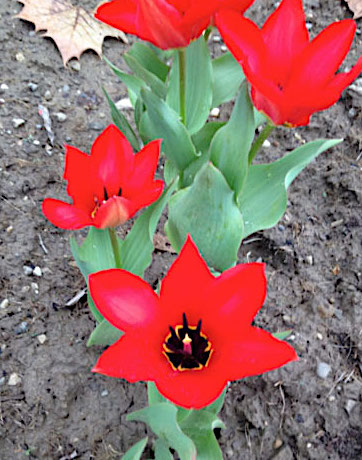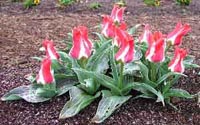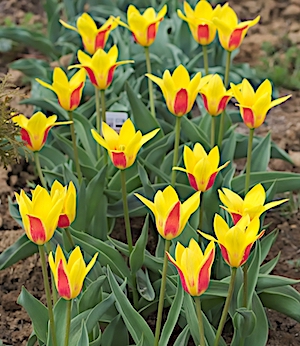Are Tulips Annuals or Perennials?
By Bethany S. Jones, Fairfax Master Gardener Intern
 One of the challenges of tulip (Tulipa) growing is to sustain your investment in good bulbs so they bloom successfully for more than one year. Many (perhaps most) gardeners treat all tulips as annuals, buying fresh bulbs in the early fall, then digging them out and either trashing them or composting them as soon as the flowers are spent. But tulips are originally perennials, so with some extra care and attention, and a bit of luck, bulbs can be encouraged to bloom again. Some basic issues are the choice of bulbs, planting strategies and perennializing techniques.
One of the challenges of tulip (Tulipa) growing is to sustain your investment in good bulbs so they bloom successfully for more than one year. Many (perhaps most) gardeners treat all tulips as annuals, buying fresh bulbs in the early fall, then digging them out and either trashing them or composting them as soon as the flowers are spent. But tulips are originally perennials, so with some extra care and attention, and a bit of luck, bulbs can be encouraged to bloom again. Some basic issues are the choice of bulbs, planting strategies and perennializing techniques.

Red Emperor Tulips

Greigi Tulip
Tulips should be planted with re-blooming in mind. Traditionally, tulips are planted with their root plates about three times their bulb height below the surface. Some gardeners believe that planting bulbs relatively deeper (1 to 2 inches) in the soil encourages a second bloom by discouraging the bulbs from multiplying, thus preserving their energy for reblooming. The bulbs need good sun (five to six hours), excellent drainage and gravelly or sandy soil. Some gardeners, who naturalize their tulips in the ground, time their fall mulching of 2 to 3 inches carefully to ensure appropriate protection against long freezes. They also watch for the right time to remove any remaining mulch in the spring so as not to impede the emergence of the first growth. Perennial tulip bulbs benefit from treatment in the spring and fall with a 10-10-10 or 10-15-10 slow release fertilizer, whereas annual tulips are not usually fertilized, since they draw their energy from the bulb until depletion.

Tarda tulip
Tulips can be perennialized either in the ground or in storage. In either case, remove the flowers after blooming but before seeds appear, then leave foliage intact in order to re-strengthen the bulbs. If the bulbs are left in place, take care not to damage them while gardening in the summer months in the same area. If they are dug out, usually in June, cut back any remaining foliage, wipe the bulbs clean, then store them in a warm (not hot), well-aired place, for replanting in the fall. Remember that even if a bulb blooms a second time, it will inevitably weaken over time, and when it does, it should be dug up and replaced.

Kaufmanniana tulip
Resources
When to Fertilize Tulip Bulbs, Chicago Botanic Garden
Bulbs & More, Planting & Care, Ron Cornwell, University of Illinois Extension
Which are the best tulips for perennializing?, Iowa State University, Extension and Outreach
Spring Flowering Bulbs, Elaine Fogerty, Rutgers, New Jersey Agricultural Experiment Station
Long Live Tulips: Home, New York Botanical Garden
Perennial Tulips, Sonia Uyterhowven, New York Botanical Garden
Species Tulips, Sherry Rindels, Iowa State University, Extension and Outreach